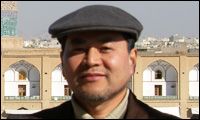
Scholars illuminates Silla-Persian royal wedding

A pre-Islamic Persian prince went to Silla in the seventh century and got married with a princess, showing how extensive the ancient kingdom was in terms of international exchanges.
Lee Hee-soo, professor of cultural anthropology at Hanyang University, found the royal marriage in the ancient Persian book, which he is researching to show the depth and width of Korea’s international profile in ancient times.
“The Kushnameh, a pre-Islamic Persian epic, gives a surprising amount of remarkable descriptions of the Korean kingdom Silla. Prince Abdin, Persian hero, married a Silla princess named Frarang with the invitation of the king, after a long and difficult adventure through Iran and China,” the professor specialized in Iran said.
“In an exaggerated remark about the abundant gold resources of Silla, the conditions of Silla must have seemed like a sort of ‘Utopia’ in the eyes of Middle Eastern people.”
According to preliminary research by an Iranian scholar, Dr. Daryoosh Akbarzade, the two cultures naturally blended each other 1,200 years ago.
Lee said analysis of artifacts such as glass bottles unearthed from ancient Silla demonstrate the same techniques used in the Persian Dynasty.
Lee said as Persian items such as carpets and wool fabrics were imported and widely used among Silla aristocrats.
“In the eigth century, Korea and the Middle East were trading by sea and by overland routes. In the seventh century, Persia was defeated by Muslim armies.
“The Islamic Persia brought about a deep transformation in the upper class, and prince Abidin escaped to China. However, he was not safe in the Tang Dynasty, so Abdin finally migrated to Silla,” he said.
Meanwhile, Ju Bo-don, a former member of National History Compilation Committee said that the fact of multi-culture marriages between Middle East and Silla might have happened late in the eighth century.
“The alleged top class marriage needs further research. But it is true that there were various cultural exchanges between Koreans and Persians and one example is the statue of an admiral with the look of Persian from ancient king tombs in Gyeong-ju, the capital of Silla,” Ju said.
Dr. Ahmed Mohammed, professor of Arabic at Hankuk University of Foreign Studies, said this historical story would influence on sustainable Korea-Middle East relations based on the cultural marketing.
“Through the Silk Road, I have heard that Indo-Persian tribe merchants were in China in 880. From this point of view, it is possible that the Persian merchants immigrated to Silla under the sincere patronage of Silla King, called Tayhur in Persian,” he said.
Lee is part of a research team comprising Korean and Iranian researchers interpreting the Kushnameh. The epic is heavily devoted historical stories from Silla. <The Korea Times/Ryu Chang-gi>


